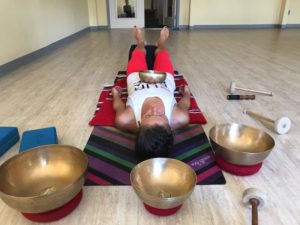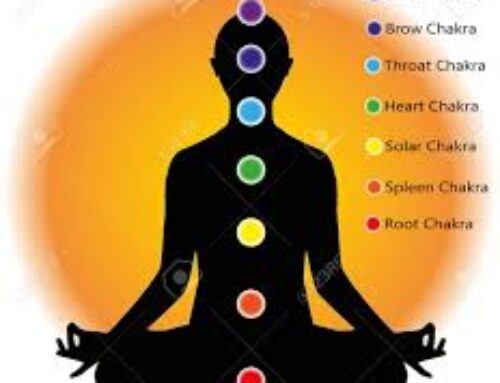Your Brain on Yoga Nidra
Learn what’s going on with your brain waves when you sink into a yoga nidra practice and why it leaves you feeling so refreshed.
NOV 1, 2017
Each time you practice yoga nidra meditation, you’re stilling the waves of the mind through conscious entry into the sleep state. How?
Yoga Nidra and Your Brain Waves
 You start with sensing the body and breathing in specific ways in order to trigger the relaxation response. The relaxation response balances the sympathetic and parasympathetic nervous systems, and balances the left and right brain. In the process, your brain shifts from beta, an awakened state with lots of brain activity, to alpha, a more relaxed state. In alpha, the mood-regulating hormone serotonin gets released, and this calms you down. People who spend little time in an alpha brain-wave state have more anxiety than those who spend more time in alpha. Think of a car: if you want to stop and turn off the engine, you first need to downshift. Shifting your brain into an alpha state starts its process of “powering down,” or coming into a rest state with slower, restorative brain-wave activity.
You start with sensing the body and breathing in specific ways in order to trigger the relaxation response. The relaxation response balances the sympathetic and parasympathetic nervous systems, and balances the left and right brain. In the process, your brain shifts from beta, an awakened state with lots of brain activity, to alpha, a more relaxed state. In alpha, the mood-regulating hormone serotonin gets released, and this calms you down. People who spend little time in an alpha brain-wave state have more anxiety than those who spend more time in alpha. Think of a car: if you want to stop and turn off the engine, you first need to downshift. Shifting your brain into an alpha state starts its process of “powering down,” or coming into a rest state with slower, restorative brain-wave activity.
From alpha, you go into a deep alpha and high theta brain-wave state, the dream state, REM sleep. In theta, your thoughts slow down to 4 to 8 thoughts per second. This is where super learning happens. Kids and artists experience a lot more theta activity in their brains. Emotional integration and release also happen here, and structures in the brain change. It’s here that some people sometimes have random thoughts or see images. A person in theta may see colors or visions or hear the voice of a person talking yet at the same time not hear this voice. It’s where you being to enter the gap of nothingness.
After theta, you are guided to delta, where your thoughts are only 1 to 3.9 thoughts per second. This is the most restorative state, in which your organs regenerate and the stress hormone cortisol is removed from your system.
When you’re put under anesthesia, you’re put into a delta brain-wave state. People in comas are also in a delta brain-wave state, which gives their bodies a chance to restore their systems. In our culture, very few people are going into the deep states of sleep like theta and delta on a regular basis, and as a consequence, our bodies are not powering down and getting the chance to restore themselves. Depressed people go to beta and alpha states, but rarely go to theta and delta.
The Fourth State of Consciousness You Can Access Through Yoga Nidra
From delta, the guided yoga nidra experience takes you down into an even deeper brain-wave state—one that can’t be reached through conventional sleep. In this fourth state of consciousness, below delta, your brain is thoughtless. This state is sort of like a complete loss of consciousness, but you are awake. This state is one of such a deep surrender, where your consciousness is so far away from the physical body, that living here every day would be difficult. Not everyone who practices yoga nidra touches this state, but the more you practice, the more you’ll receive glimpses of it.
After you touch into the fourth state of consciousness, you are guided back to a waking state. Again, you couldn’t live in this fourth state, but as a result of touching into it, you bring a little of its peace back with you to your waking, everyday brain state. You also are able to rewire your thoughts and emotions because your subconscious mind in this fourth state is fertile, more open to intentions and affirmations, than it is when you are in your waking state. As a consequence, in your everyday life, you begin to rest more and more in the space between emotions and thoughts, and this resting in this space gives rise to a sense of freedom, where you are not triggered so much by the stuff in your life.
Plus, in yoga nidra meditation, you are often asked to bring your attention to the space between your eyebrows—a spot known as the third eye. Behind this spot lies the pineal gland, and this gland is stimulated when you bring your attention there. Studies confirm that the pineal-gland hormone, melatonin, is a powerful agent for reducing stress, inducing more restful sleep, and boosting the immune system, which helps prevent illness, promote healing, and slow premature aging.
The Benefits of Yoga Nidra
While yoga nidra is not a substitute for sleep, the number one reason most women I know say yes to yoga nidra is that it’s widely touted that 45 minutes of yogic sleep feels like 3 hours of regular sleep. There’s some debate over the science that backs this up, but it is likely this effect is due to the series of brain-wave changes experienced during yoga nidra. In my work, I hear women tell me all the time that they wake up deeply refreshed after practicing yoga nidra and that yoga nidra helps them fall asleep and get back to sleep at night. Who can say no to sleep?
As you can imagine, feeling well rested is life changing, but yoga nidra also improves your overall health. A 2013 study showed that practicing yoga nidra improved anxiety, depression, and overall well-being for women experiencing menstrual irregularities and psychological problems. I’ve worked with many women who have had tremendous success using yoga nidra to help them manage pre- and post-surgical operations and decrease pain. And even more science points to how yoga nidra can help lower blood pressure and cholesterol and improve blood glucose fluctuations and symptoms associated with diabetes.







Leave A Comment